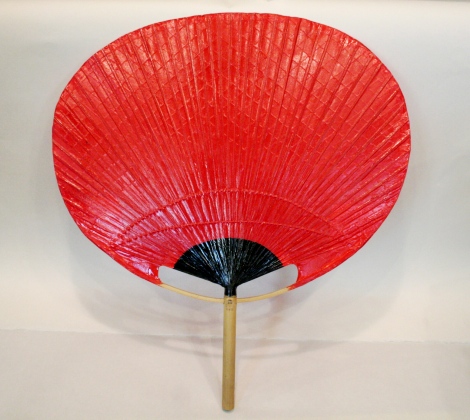Well anyone that knows me on deivantART is probably fammiliar with my Naruto OC, Luna Hyuuzu, and anyone that is fammiliar with her is probably aware of the fact that she collects and has her bedroom decorated with various Japanese War Fans, so I thought I would share my vast knowledge of Japanese War Fans! :D
Not including standard folding fans, there are four different types of Japanese War Fans: Uchiwa, Gunsen, Saihai, and Tessen.
First, let's look at the standard Japanese folding fan
STANDARD JAPANESE FOLDING FAN

The folding fan was invented in Japan in the 8th century and taken to China in the 9th century. The Akomeogi (or Japanese folding fan; 衵扇; Hiōgi) originated in the 6th century. These were fans held by aristocrats of the Heian period when formally dressed. They were made by tying thin stripes of hinoki (or Japanese cypress) together with thread. The number of strips of wood differed according to the person's rank.
UCHIWA

The uchiwa (round fan) is a traditional Japanese handicraft with a long tradition. Originally from China, it is made by cutting a bamboo tube into narrow splinters which are then splayed out in the radial shape of a fan. Over both sides of this bamboo frame is pasted "washi" paper. Sometimes they were also made of iron, built on wooden cores. They were used to ward off arrows, as a sunshade, and to signal to troops. They are also used in Japanese court and to fan flames.
GUNSEN

Gunsen were folding fans used by the average samurai warriors to cool themselves off. They were made of bronze, brass or a similar metal for the inner spokes, and often used iron for the outer spokes, making them lightweight but strong. Warriors would hang their fans from a variety of places, most typically from the belt or the breastplate, though the latter often impeded the use of a sword or a bow.
SAIHAI

Saihai (also called Zai) is a very important article for directing troops. Every monogashira (captain) and all officers of higher rank carry it. To carry it, fasten the cord (also called udenuki-no-o) to the ring of the right chigakushi (small piece on the upper part of the breastplate), and put you left hand into the cord. When not in use put it at the back of the waist.
TESSEN

Tessen were folding fans with outer spokes made of iron which were designed to look like normal, harmless folding fans or solid clubs shaped to look like a closed fan. Samurai and Ninja could take these to places where swords or other overt weapons were not allowed, and some swordsmanship schools included training in the use of the tessen as a weapon. The tessen was also used for fending off arrows and darts, as a throwing weapon, and as an aid in swimming. The outer edge of the fan could also be sharpened so they could also be used to cut an opponent. The fighting style of using a fan is called TESSENJUTSU.
and there's also special made fans for dancers
DANCER FANS

Of course, dancing with fans is popular in Japanese culture. Dancing fans are made specially light-weight so that the dancer can move them easily.
Fans are also used as a marriage proposal in Japan
WEDDING FANS

The engagement of a traditional Japanese wedding is sealed by a ceremony called the yunio. The highlight of this ceremony is the giving of symbolic gifts wrapped in ornate rice paper. The gifts include: dried cuttlefish for its phallic shape; kelp or konbu because the character can be written to mean "child-bearing woman"; a long, linen thread to symbolize the gray hair of old age; and a folded fan which spreads out to show future wealth and growth in numbers.
I know I'm not an expert on Japanese things...but they sure are fun to research :D
if I messed up anything, please feel free to correct me ^_^;
Not including standard folding fans, there are four different types of Japanese War Fans: Uchiwa, Gunsen, Saihai, and Tessen.
First, let's look at the standard Japanese folding fan
STANDARD JAPANESE FOLDING FAN

The folding fan was invented in Japan in the 8th century and taken to China in the 9th century. The Akomeogi (or Japanese folding fan; 衵扇; Hiōgi) originated in the 6th century. These were fans held by aristocrats of the Heian period when formally dressed. They were made by tying thin stripes of hinoki (or Japanese cypress) together with thread. The number of strips of wood differed according to the person's rank.
UCHIWA

The uchiwa (round fan) is a traditional Japanese handicraft with a long tradition. Originally from China, it is made by cutting a bamboo tube into narrow splinters which are then splayed out in the radial shape of a fan. Over both sides of this bamboo frame is pasted "washi" paper. Sometimes they were also made of iron, built on wooden cores. They were used to ward off arrows, as a sunshade, and to signal to troops. They are also used in Japanese court and to fan flames.
GUNSEN

Gunsen were folding fans used by the average samurai warriors to cool themselves off. They were made of bronze, brass or a similar metal for the inner spokes, and often used iron for the outer spokes, making them lightweight but strong. Warriors would hang their fans from a variety of places, most typically from the belt or the breastplate, though the latter often impeded the use of a sword or a bow.
SAIHAI

Saihai (also called Zai) is a very important article for directing troops. Every monogashira (captain) and all officers of higher rank carry it. To carry it, fasten the cord (also called udenuki-no-o) to the ring of the right chigakushi (small piece on the upper part of the breastplate), and put you left hand into the cord. When not in use put it at the back of the waist.
TESSEN

Tessen were folding fans with outer spokes made of iron which were designed to look like normal, harmless folding fans or solid clubs shaped to look like a closed fan. Samurai and Ninja could take these to places where swords or other overt weapons were not allowed, and some swordsmanship schools included training in the use of the tessen as a weapon. The tessen was also used for fending off arrows and darts, as a throwing weapon, and as an aid in swimming. The outer edge of the fan could also be sharpened so they could also be used to cut an opponent. The fighting style of using a fan is called TESSENJUTSU.
and there's also special made fans for dancers
DANCER FANS

Of course, dancing with fans is popular in Japanese culture. Dancing fans are made specially light-weight so that the dancer can move them easily.
Fans are also used as a marriage proposal in Japan
WEDDING FANS

The engagement of a traditional Japanese wedding is sealed by a ceremony called the yunio. The highlight of this ceremony is the giving of symbolic gifts wrapped in ornate rice paper. The gifts include: dried cuttlefish for its phallic shape; kelp or konbu because the character can be written to mean "child-bearing woman"; a long, linen thread to symbolize the gray hair of old age; and a folded fan which spreads out to show future wealth and growth in numbers.
I know I'm not an expert on Japanese things...but they sure are fun to research :D
if I messed up anything, please feel free to correct me ^_^;

No comments:
Post a Comment